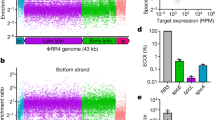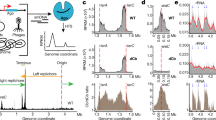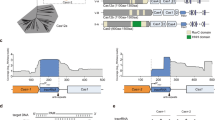Abstract
In bacteria and archaea, small RNAs derived from clustered, regularly interspaced, short palindromic repeat (CRISPR) loci are involved in an adaptable and heritable gene-silencing pathway. Resistance to phage infection is conferred by the incorporation of short invading DNA sequences into the genome as CRISPR spacer elements separated by short repeat sequences. Processing of long primary transcripts (pre-crRNAs) containing these repeats by an RNA endonuclease generates the mature effector RNAs that interfere with phage gene expression. Here we describe structural and functional analyses of the Thermus thermophilus CRISPR Cse3 endonuclease. High-resolution X-ray structures of Cse3 bound to repeat RNAs model both the pre- and post-cleavage complexes associated with processing the pre-crRNA. These structures establish the molecular basis of a specific CRISPR RNA recognition and suggest the mechanism for generation of effector RNAs responsible for gene silencing.
This is a preview of subscription content, access via your institution
Access options
Subscribe to this journal
Receive 12 print issues and online access
$189.00 per year
only $15.75 per issue
Buy this article
- Purchase on Springer Link
- Instant access to full article PDF
Prices may be subject to local taxes which are calculated during checkout




Similar content being viewed by others
References
Ishino, Y., Shinagawa, H., Makino, K., Amemura, M. & Nakata, A. Nucleotide sequence of the iap gene, responsible for alkaline phosphatase isozyme conversion in Escherichia coli, and identification of the gene product. J. Bacteriol. 169, 5429–5433 (1987).
Nakata, A., Amemura, M. & Makino, K. Unusual nucleotide arrangement with repeated sequences in the Escherichia coli K-12 chromosome. J. Bacteriol. 171, 3553–3556 (1989).
Barrangou, R. et al. CRISPR provides acquired resistance against viruses in prokaryotes. Science 315, 1709–1712 (2007).
Brouns, S.J. et al. Small CRISPR RNAs guide antiviral defense in prokaryotes. Science 321, 960–964 (2008).
Carte, J., Wang, R., Li, H., Terns, R.M. & Terns, M.P. Cas6 is an endoribonuclease that generates guide RNAs for invader defense in prokaryotes. Genes Dev. 22, 3489–3496 (2008).
Jansen, R., Embden, J.D., Gaastra, W. & Schouls, L.M. Identification of genes that are associated with DNA repeats in prokaryotes. Mol. Microbiol. 43, 1565–1575 (2002).
Marraffini, L.A. & Sontheimer, E.J. CRISPR interference limits horizontal gene transfer in staphylococci by targeting DNA. Science 322, 1843–1845 (2008).
Haft, D.H., Selengut, J., Mongodin, E.F. & Nelson, K.E. A guild of 45 CRISPR-associated (Cas) protein families and multiple CRISPR/Cas subtypes exist in prokaryotic genomes. PLoS Comput. Biol. 1, e60 (2005).
Kunin, V., Sorek, R. & Hugenholtz, P. Evolutionary conservation of sequence and secondary structures in CRISPR repeats. Genome Biol. 8, R61 (2007).
Makarova, K.S., Grishin, N., Shabalina, S., Wolf, Y. & Koonin, E. A putative RNA-interference-based immune system in prokaryotes: computational analysis of the predicted enzymatic machinery, functional analogies with eukaryotic RNAi, and hypothetical mechanisms of action. Biol. Direct 1, 7–33 (2006).
Grissa, I., Vergnaud, G. & Pourcel, C. The CRISPRdb database and tools to display CRISPRs and to generate dictionaries of spacers and repeats. BMC Bioinformatics 8, 172–182 (2007).
Agari, Y. et al. Transcription profile of Thermus thermophilus CRISPR systems after phage infection. J. Mol. Biol. 395, 270–281 (2010).
Wiedenheft, B. et al. Structural basis for DNase activity of a conserved protein implicated in CRISPR-mediated genome defense. Structure 17, 904–912 (2009).
Han, D. & Krauss, G. Characterization of the endonuclease SSO2001 from Sulfolobus solfataricus P2. FEBS Lett. 583, 771–776 (2009).
Pougach, K. et al. Transcription, processing and function of CRISPR cassettes in Escherichia coli. Mol. Microbiol. 77, 1367–1379 (2010).
Xue, S., Calvin, K. & Li, H. RNA recognition and cleavage by a splicing endonuclease. Science 312, 906–910 (2006).
Calvin, K., Xue, S., Ellis, C., Mitchell, M. & Li, H. Probing the catalytic triad of an archaeal RNA splicing endonuclease. Biochemistry 47, 13659–13665 (2008).
Ebihara, A. et al. Crystal structure of hypothetical protein TTHB192 from Thermus thermophilus HB8 reveals a new protein family with an RNA recognition motif-like domain. Protein Sci. 15, 1494–1499 (2006).
Haurwitz, R.E., Jinek, M., Wiedenheft, B., Zhou, K. & Doudna, J. Sequence- and structure-specific RNA processing by a CRISPR endonuclease. Science 329, 1355–1358 (2010).
Deo, R.C., Bonanno, J.B., Sonenberg, N. & Burley, S.K. Recognition of polyadenylate RNA by the poly(A)-binding protein. Cell 98, 835–845 (1999).
Handa, N. et al. Structural basis for recognition of the tra mRNA precursor by the Sex-lethal protein. Nature 398, 579–585 (1999).
Wang, R., Preamplume, G., Terns, M.P., Terns, R.M. & Li, H. Interaction of the Cas6 riboendonuclease with CRISPR RNAs: recognition and cleavage. Structure 19, 257–264 (2011).
Schmidt, B.H., Burgin, A.B., Deweese, J.W., Osheroff, N. & Berger, J.M. A novel and unified two-metal mechanism for DNA cleavage by type II and IA topoisomerases. Nature 465, 641–644 (2010).
Guillén Schlippe, Y.V. & Hedstrom, L. A twisted base? The role of arginine in enzyme-catalyzed proton abstractions. Arch. Biochem. Biophys. 433, 266–278 (2005).
Steitz, T.A. & Steitz, J.A. A general two-metal ion mechanism for catalytic RNA. Proc. Natl. Acad. Sci. USA 90, 6498–6502 (1993).
Igloi, G.L. & Kossel, H. Affinity electrophoresis for monitoring terminal phosphorylation and the presence of queuosine in RNA. Application of polyacrylamide containing a covalently bound boronic acid. Nucleic Acids Res. 13, 6881–6898 (1985).
Otwinowski, Z. & Minor, W. Processing of X-ray diffraction data collected in oscillation mode. Methods Enzymol. 276, 307–326 (1997).
Emsley, P. & Cowtan, K. Coot: model-building tools for molecular graphics. Acta Crystallogr. D Biol. Crystallogr. 60, 2126–2132 (2004).
Murshudov, G.N., Vagin, A.A. & Dodson, E.J. Refinement of macromolecular structures by the maximum-likelihood method. Acta Crystallogr. D Biol. Crystallogr. 53, 240–255 (1997).
Read, R.J. Pushing the boundaries of molecular replacement with maximum likelihood. Acta Crystallogr. D Biol. Crystallogr. 57, 1373–1382 (2001).
Lovell, S.C. et al. Structure validation by Cα geometry: ϕ,ψ and Cβ deviation. Proteins 50, 437–450 (2003).
Acknowledgements
This work was supported by an operating grant from the Natural Sciences and Engineering Research Council of Canada (NSERC) to A.M.M. We are also grateful for the support of the Alberta Synchrotron Institute during the early stages of this work.
Author information
Authors and Affiliations
Contributions
E.M.G. cloned, expressed and biochemically characterized Cse3 and Cse3 mutants, purified the proteins and protein–RNA complexes and grew the crystals. M.J.S. solved the structures. E.L.G. and M.M.G. cloned, expressed and purified Cse3 mutants. E.M.G., M.J.S., E.L.G. and A.M.M. designed the experiments and contributed to writing the manuscript.
Corresponding author
Ethics declarations
Competing interests
The authors declare no competing financial interests.
Supplementary information
Supplementary Text and Figures
Supplementary Figures 1–6 (PDF 1743 kb)
Rights and permissions
About this article
Cite this article
Gesner, E., Schellenberg, M., Garside, E. et al. Recognition and maturation of effector RNAs in a CRISPR interference pathway. Nat Struct Mol Biol 18, 688–692 (2011). https://doi.org/10.1038/nsmb.2042
Received:
Accepted:
Published:
Issue Date:
DOI: https://doi.org/10.1038/nsmb.2042
This article is cited by
-
Digging into the lesser-known aspects of CRISPR biology
International Microbiology (2021)
-
The host-encoded RNase E endonuclease as the crRNA maturation enzyme in a CRISPR–Cas subtype III-Bv system
Nature Microbiology (2018)
-
Genetics of CRISPR arrays in Salmonella Typhimurium 14028 associated with foreign DNA decay
Genes & Genomics (2018)
-
Alternate binding modes of anti-CRISPR viral suppressors AcrF1/2 to Csy surveillance complex revealed by cryo-EM structures
Cell Research (2017)
-
The role of ribonucleases in regulating global mRNA levels in the model organism Thermus thermophilus HB8
BMC Genomics (2014)



